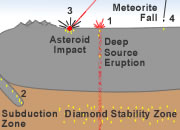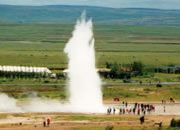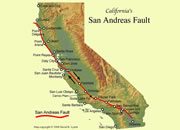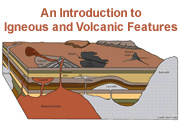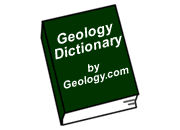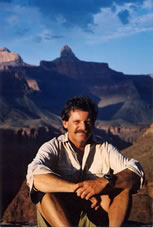Home » General Geology » Age of the Grand Canyon
How Old Is the Grand Canyon?
Written by Wayne Ranney, author of Carving Grand Canyon: Evidence, Theories and Mystery.
Introduction
The Grand Canyon is one of the most recognizable landforms on planet Earth and the most often asked question about it is, "When did it form?" If only there were a simple answer! Geologists still debate many of the details about the origin and age of the canyon but recent geologic research has shed new light on the topic. Using new, sophisticated laboratory techniques geologists are able to tease ever more information from the canyon's seemingly stubborn rocks. To begin to grasp the age of the canyon we should also know something about the history of the Colorado River, for without this river (or at least some ancestor to it) there would be no Grand Canyon.
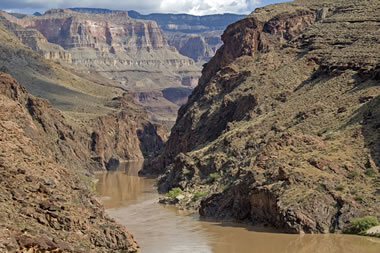
Grand Canyon and Colorado River: The Colorado River, or some ancestor to it, has carved the Grand Canyon. But as new techniques are developed to tease ever more information from the canyon's rocks, the age of the canyon becomes more of a puzzle. Traditionally, the age of the canyon is ascribed at 6 million years but this date refers specifically to when the modern Colorado River came into existence. Could a precursor to the Colorado River have initiated the cutting of the canyon? Some geologists think so. Click here to enlarge. Image copyright Wayne Ranney.
The Early River
Geologists know that the canyon and the river had to have formed within the last 80 million years because this is when the sea was last present here. When the landscape was uplifted from this seabed, an initial river system developed and drained to the northeast, exactly opposite to the flow direction of the Colorado River today. The larger geologic setting of the American West at this time reveals that an Andean-type mountain range existed to the southwest of Grand Canyon near the modern-day cities of Las Vegas, Nevada; Kingman, Arizona; and Needles, California. This ancient range is where the ancestor of the Colorado River originated. As strange as this may sound, it is one of the few parts of the Colorado River story that all geologists agree upon.
An Early Canyon?
A new theory published in 2011 contends that this ancient northeast river system carved the Grand Canyon as early as 70 million years ago. Using a technique that can tell how deeply buried the canyon's rocks were at specific time intervals, scientists determined that western Grand Canyon was cut to within a few hundred meters of its present depth 70 million years ago, while eastern Grand Canyon (where most visitors see the canyon) was the site of a gorge of similar proportions to the modern canyon, but cut into Mesozoic-age rocks that are now completely stripped away. This evidence flies in the face of many long held theories that the canyon is only about 6 million years old. The notion that the Grand Canyon could be old is not a completely new idea but the recent research uses more cutting-edge tools to arrive at this conclusion. Look for vigorous debate in the near future regarding this mind-blowing proposal.
A Recent Colorado River and Grand Canyon
Support for a recent river and canyon comes from the area around the mouth of Grand Canyon (Grand Wash Cliffs) near Meadview, Arizona. The Muddy Creek Formation lies athwart the river's course here but has no recognizable Colorado River sediment within it - the interpretation is that the river was not in existence while the Muddy Creek Formation was accumulating. The deposit is as young as 6.0 million years and this is where the famous date for the canyon and the river is derived from. Just downstream are definitive Colorado River gravels that came from Grand Canyon and they are preserved beneath the Sandy Point basalt, dated at 4.4 million years. Taken together the evidence suggests that the river here is between 6.0 and 4.4 million years old and geologists have often conflated the age of the river as the age of the canyon. Some geologists think there was no part of the canyon in existence before 6.0 million years ago; others think it took much longer to form it.
Wayne Ranney is a geologist, river and trail guide, and award winning
science writer. He specializes in making complex scientific ideas more
accessible and meaningful to non-specialists. His research interests include
the landscape development and stratigraphy of the American Southwest, and
developing ways to help the general public appreciate scientific thought.
His books include "Carving Grand Canyon", "Sedona Through Time", and
"Ancient Landscapes of the Colorado Plateau". He lives in Flagstaff, Arizona
with his wife Helen.
Contact: wayneranney17@gmail.com
|
What Process Formed Grand Canyon?
Two major processes are used to explain how the Grand Canyon formed - headward erosion and stream piracy, and basin spillover. Headward erosion and stream piracy is the historical favorite but few studies have come to its defense in recent decades. Basin spillover is currently receiving a lot of attention, especially for the lower Colorado River between Hoover Dam and Yuma, Arizona. Geologists have documented a series of closed basins that filled rapidly with river water, spilling over their lowest rims to stitch together the Las Vegas, Cottonwood, Mojave, and Chemehuevi basins, all between 5.6 and 4.1 million years ago. They naturally wondered what caused the rapid arrival of water to these basins and of course, looked figuratively and literally upstream towards the Grand Canyon. We may never know but that is part of the beauty of this marvelous place.
As a final note, remember that what constitutes a "beginning" to the Grand Canyon hinges on a definition of what it is. Can its beginning be defined as when the earliest river eroded into any Grand Canyon strata? What if those same rivers sliced into strata now completely gone? What if a river going in the other direction cut the canyon? Would that still be considered Grand Canyon? Or is the definition completely dependent on a canyon being cut by the exact same river we see today? The definition of "beginning" seems to be a moving target and will aid in knowing why this story is so hard to tell. There are so many possibilities with only one large canyon.

Find Other Topics on Geology.com:
 | Rocks: Galleries of igneous, sedimentary and metamorphic rock photos with descriptions. |
|
 | Minerals: Information about ore minerals, gem materials and rock-forming minerals. |
|
 | Volcanoes: Articles about volcanoes, volcanic hazards and eruptions past and present. |
|
 | Gemstones: Colorful images and articles about diamonds and colored stones. |
|
 | General Geology: Articles about geysers, maars, deltas, rifts, salt domes, water, and much more! |
|
 | Geology Store: Hammers, field bags, hand lenses, maps, books, hardness picks, gold pans. |
|

|
 | Diamonds: Learn about the properties of diamond, its many uses, and diamond discoveries.
|
|


